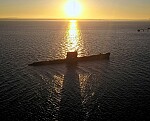INS Tushil: India's advanced frigate with Russian origins
The Indian Navy has added a new warship to its fleet, the INS Tushil, a missile frigate that encapsulates the intricate ties between India, Russia, and Ukraine. Originally intended for Russia’s navy, the INS Tushil now represents a broader narrative of geopolitical shifts, technological limitations, and India's growing maritime ambitions.
_entering_the_port_of_Manama%2C_Bahrain.jpg)
A Rising Naval Power in the Shadows of Giants
Historically, the Indian Navy has operated in the shadow of global naval superpowers like the United States, China, and the once-dominant Russia. Yet, India's fleet has quietly grown into one of the most diverse and capable in the world. According to available data, the Indian Navy now operates:
- Two aircraft carriers: the indigenous INS Vikrant (40,000 tons) and INS Vikramaditya, a modified Kiev-class carrier (45,400 tons) acquired from Russia.
- Seven amphibious landing ships, 13 destroyers, 13 frigates, and 20 corvettes.
- Submarines: two Arihant-class nuclear-powered ballistic missile submarines and 16 conventionally powered attack submarines.
This fleet puts India in a position to challenge fading Russian naval dominance, especially in surface warfare.
INS Tushil: From Russian Blueprint to Indian Reality
The INS Tushil, part of the Talwar-class (Project 11356), is the seventh frigate in this lineage. It was originally commissioned by Russia for its Black Sea Fleet but later repurposed for India due to political and logistical complications. According to Naval News, the frigate features 26% Indian components, a modest figure on paper, but these components are critical, signaling India's increasing autonomy in defense manufacturing.
The frigate was produced as part of a broader India-Russia military-technical cooperation agreement spanning 2021–2031. This agreement also includes collaborations on T-90 tanks, Su-30 aircraft, and MiG-29 jets. However, the deal has faced significant challenges, reflecting broader issues within Russia's defense industry.
From Crimea to India: A Frigate's Unlikely Journey
The annexation of Crimea in 2014 disrupted Russia’s defense supply chain, especially the procurement of gas turbines from Ukraine's Zorya-Mashproekt. The INS Tushil, originally intended for Russia, became a diplomatic and logistical workaround. India purchased the turbines from Ukraine, which were then sent to Russia to complete the frigate's construction. A similar arrangement is expected for its sister ship, INS Tamala.
This unusual arrangement highlights the precarious state of Russian defense manufacturing, which increasingly relies on external inputs. The INS Tushil's engines and transmissions, for instance, are of Indian origin, emphasizing the ship's hybrid nature.
India’s Technological Mark on the INS Tushil
One of the most telling aspects of INS Tushil is its reliance on Indian technology. While Russia traditionally supplied the radars and fire control systems for such ships, India's advancements in these areas have reduced dependence. Approximately half of the frigate’s electronics are now Indian-made, including its advanced radar systems and fire control components.
This shift correlates with broader issues in Russian defense systems, as seen in their performance during the ongoing conflict in Ukraine. Russian weapon systems, particularly in targeting and accuracy, have shown significant deficiencies. India’s decision to equip the INS Tushil with its own components reflects a desire to bridge these gaps and reduce vulnerabilities.
The frigate is also armed with PJ-10 BrahMos cruise missiles, a joint venture between India and Russia, instead of the Russian Kalibr or Oniks missiles. The BrahMos represents a significant leap in capability, offering unparalleled precision and range.
The Smaller but Potent Frigate
The INS Tushil displaces 4,100 tons, smaller than its Western counterparts, which typically exceed 8,000 tons for frigates. By Western standards, it might qualify as a corvette, yet it remains a versatile and heavily armed vessel. Its top speed of 30 knots and a crew of 180 sailors indicate a lower level of automation compared to similar-sized Western ships. For context, the American Zumwalt-class destroyers, which are nearly four times larger, operate with a similarly sized crew.
Implications for Russia and India
The story of INS Tushil underscores the challenges facing Russia’s defense industry. Once a global powerhouse, Moscow now struggles with supply chain issues, reliance on external technologies, and a diminishing capacity to deliver advanced systems on time. This has pushed India to enhance its domestic defense production, gradually replacing Russian technologies with indigenous alternatives.
For India, the INS Tushil is more than just another ship in its fleet. It represents a step toward self-reliance and technological maturity, vital for maintaining a credible maritime presence in the Indo-Pacific. It also reflects India’s pragmatic approach to navigating complex geopolitical relationships, leveraging ties with Russia, Ukraine, and other partners to bolster its capabilities.
Conclusion
The INS Tushil is a microcosm of shifting global dynamics in defense and technology. It embodies India’s growing maritime ambitions and the challenges facing Russia’s once-mighty defense industry. As India continues to assert itself as a regional power, ships like the INS Tushil will play a crucial role in shaping the balance of power in the Indo-Pacific and beyond.










